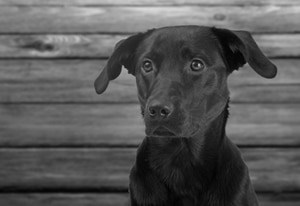 Veterinarians and certified veterinary technicians are well trained in how to treat a variety of different species, from house pets to farm animals. A veterinarian can have a range of experiences with these different animals throughout their day, so understanding how to manage anxious pets is an important skill. Many dog owners deal with destructive behavior in their pet, which leads them to seek out professional advice on how to deal with and train their furry friend. A common complaint of dog owners who seek out extra help in managing their dog’s behavior is that their pet is destructive when it is left alone. Some dogs bark, howl, chew, dig or soil their space, and while many dogs simply need to be trained in house manners, some of these symptoms indicate distress. Many dogs who show anxiety or have drooling problems when their owner prepares to leave the house suffer from separation anxiety, the same way it manifests in humans.1 Separation anxiety in dogs is triggered when the dog feels extreme stress at being separated from its guardian, or the people it is attached to. Many dogs experiencing this form of anxiety attempt to escape from their crate or room, which can result in self-injury and destruction of the home, particularly around exit points like windows and doors.
Veterinarians and certified veterinary technicians are well trained in how to treat a variety of different species, from house pets to farm animals. A veterinarian can have a range of experiences with these different animals throughout their day, so understanding how to manage anxious pets is an important skill. Many dog owners deal with destructive behavior in their pet, which leads them to seek out professional advice on how to deal with and train their furry friend. A common complaint of dog owners who seek out extra help in managing their dog’s behavior is that their pet is destructive when it is left alone. Some dogs bark, howl, chew, dig or soil their space, and while many dogs simply need to be trained in house manners, some of these symptoms indicate distress. Many dogs who show anxiety or have drooling problems when their owner prepares to leave the house suffer from separation anxiety, the same way it manifests in humans.1 Separation anxiety in dogs is triggered when the dog feels extreme stress at being separated from its guardian, or the people it is attached to. Many dogs experiencing this form of anxiety attempt to escape from their crate or room, which can result in self-injury and destruction of the home, particularly around exit points like windows and doors.
Many different symptoms of separation anxiety exist in dogs
According to the American Society for the Prevention of Cruelty to Animals (ASPCA), many more dogs are being adopted from shelters today than ever before. Because families do not often raise a dog from puppyhood, some believe those adopted dogs experience separation anxiety because they previously lost a person or group that was important to them.1 Separation anxiety in dogs can manifest as destructive behavior, depression or agitation when the pet senses its owner is about to leave, or when its owner is not present. Dogs will stop eating, attempt to keep their owners from leaving, or display other symptoms of despair. For veterinarians or technicians who counsel pet owners on the best way to manage their dog’s stress levels, the goal is to treat the dog’s underlying anxiety by teaching it how to tolerate and even enjoy being left alone.1 However, other less dramatic events can also trigger the disorder. The change of a guardian, disruption in the dog’s schedule or place of residence, or a transition in household membership (whether by the addition of someone new or the death or departure of someone familiar) can all cause a dog distress.1
Veterinarians can take an active role in managing anxiety in dogs
When a dog owner is seeking help to train their pet or manage its anxiety, a vet tech or veterinarian will need a complete medical history to learn about patterns that have been established and whether physical conditions could be the cause of stress for the dog. Veterinarians will study the dog’s training history, its level of daily physical activity, when the dog first displayed destructive or depressed behavior, and how long that anxiety has been manifesting itself.1 Owners should report any unusual behavior to their vets to rule out any medical problems. During the dog’s physical exam, veterinarians should perform a complete blood count and a biochemical profile, and order a urinalysis. The results of these tests will tell the vet if there are any problems with the dog’s internal organs that may cause excessive urination or defecation that may be misconstrued as destructive behavior. Sometimes imbalances of the thyroid hormone can lead to this type of conduct in dogs.2 Veterinarians and technicians may suggest a variety of different methods for relieving stress, starting with counterconditioning. This is a treatment process that works to change an animal’s fearful, anxious or aggressive reaction into a comfortable, relaxed one instead. This is accomplished by associating the sight or presence of a feared or disliked person, animal, place, object or situation with something that the dog loves. Over time, the dog will learn that whatever it feels anxious about does not mean anything bad will happen.1 Vets may suggest ways to develop this kind of association. For example, an owner can offer their dog a puzzle toy filled with food that will take an extended period of time to finish. The owner should be advised to remove the special toy when they return home so that their dog only has access to it when it is alone. However, veterinarians and dog trainers alike have found this approach will only be effective for mild cases of separation anxiety because many highly anxious dogs will not eat when their guardians are absent.1 Other newer methods for treating stress in dogs include more holistic approaches like acupuncture, nutrition and massage therapy. Many human patients seek out alternative approaches to chronic conditions, and this trend is extending to the treatment of pets as well. More research about the efficacy of alternative therapies is needed, but veterinary students should be familiar with holistic treatment options when counseling owners of anxious pets.3 1 “Separation Anxiety,” ASPCA.org, http://www.aspca.org/pet-care/virtual-pet-behaviorist/dog-behavior/separation-anxiety 2 “Destructive Behavior in Dogs,” Pet MD.com, http://www.petmd.com/dog/conditions/behavioral/c_dg_destructive_behavior 3 MacMillan, Molly, “Mobile veterinarian treats with alternative medicine,” Cape Gazette.com, Feb. 06, 2014, http://capegazette.villagesoup.com/p/mobile-veterinarian-treats-with-alternative-medicine/1103670



